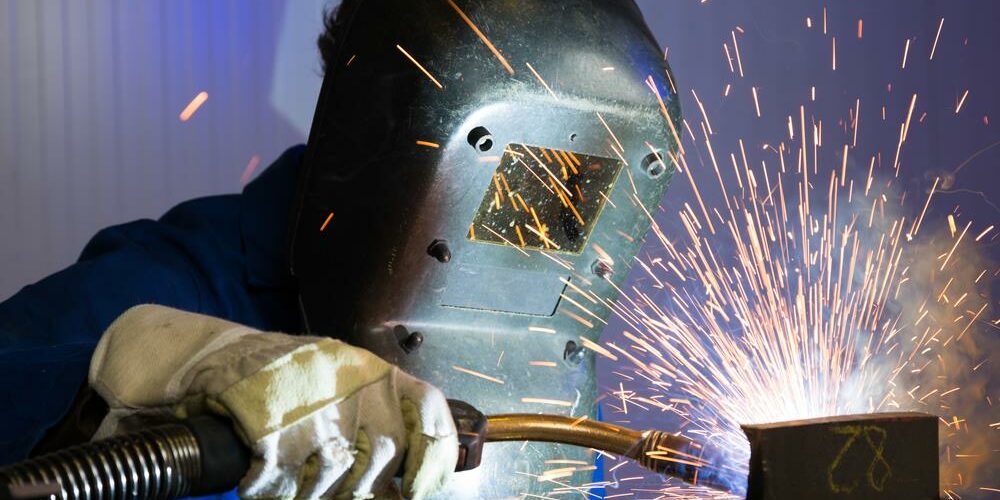Safety in welding is more than a priority. One of the most critical parts are face and eyes, which are exposed to radiation (ultraviolet or infrared), sparks and spatters, and other environmental hazards associated to welding.That is the reason why welders, beginners or advanced, should take their time to choose a welding helmet among the wide range of options: passive or auto-darkening, fixed or variable shade, two, three or four sensors…
Apart from providing comfort, this safety tool can have a significant influence in productivity and weld quality.
Here are eight considerations you need to keep in mind when selecting your welding helmet:
1. Meet quality standards.
The helmet you choose should meet ANSI (*) z87.1 – 2003 (also referred to as ANSI Z87+) or European BS EN 175:1997 standards.
2. Passive vs auto-darkening lens.
Auto-darkening welding helmets darken when welders strike the arc. The major advantage of this kind of helmet, is that even if electronic fails, it provides some minimum levels of protection, according to the ANSI standard. Furthermore, all auto-darkening helmets meeting the standards provide 100 % protection against harmful infrared and UV rays and may range from a #8 shade for a low-amp applications up to #13 shade for high-amp applications.
Passive welding helmets are worn in the up position and welders flip them into position immediately before striking an arc, with a quick nod or snap of the neck. They are an economical choice but:
• For beginners or non-experts, it can be difficult to position the electrode while the helmet is snapped into place. This can lead to poor weld starts, which may lead to weld defects or the need for excessive grinding.
• Tack welding, or numerous short welds, can be difficult and inefficient since the welder has to repeatedly lift and lower the welding helmet.
• The repetitive task of flipping the helmet up and down can cause neck fatigue, and, in some cases, may lead to repetitive stress injuries.
• Failure of the helmet to lock into position or improper timing can lead to inadvertent arc flashes if the arc strikes before the helmet is in place.
3. Fixed vs variable shade lens.
If you have chosen auto-darkening lens, then you have to select between fixed and variable shade lens, depending of your welding needs. Fixed can only darken to a predefined shade of usually #10. These are very useful to weld with a single process and a single material. For more processes and materials, it is better to choose a variable-shade one.
4. Lens reaction time.
It is the time it takes the lens to darken the moment the weld sparks. It should be extremely fast. The slightest delay can cause the so-called ‘arc eye’, that is discomfort and dry feeling in the eyes, that can lead into a major damage to the eyes. Speed ranges between the 1/3,600 of a second (for entry-level lenses) and the 1/20,000 of industrial or professional ones. The larger the fraction the faster the lens reaction time.
5. Arc Sensors.
The difference between basic and more professional auto-darkening welding helmets is the number of sensors that detect the weld sparks to start the darkening process. Basic helmets have two, while more advanced ones have three or four.
6. Weight and comfort.
Since welders are wearing the helmet for hours these two factors may be taking into account to reduce neck fatigue and other injuries. Some recommendations at this point are: choose a one-pound weight helmet, try it and adjust it, to see if its comfortable and make sure the headgear and the headband are also comfortable and of good quality and that they fit you.
7. Viewing area.
Each welding helmet has its own viewing area, you should try different options to see which one is the best fit for you. It depends on if you prefer a wider viewing area or a narrower one that allows you to focus on an specific area. The quality of the helmet affects directly the way you perceive the welding bead and its environment, and therefore, it affects the quality of your work.
8. Choose a reputable brand
Even though this tip could be applied to many different industries and products, it is even more important in the welding industry, when you are working at very high temperatures or difficult positions, you must make sure your equipment is working properly. Big brands in welding have years of experience working directly with welders, providing high-quality equipment and listening to their feedback.
Listen to your experienced colleagues and their advice, their experience with different brands can be really valuable when choosing a brand over other. Sometimes it is not only about the price and quality, but about the support they provide to clients or the replacement parts they can provide.
If you are going to be or you already are a professional welder, you should take your time to choose the welding helmet that better suits your welding needs and environment.
(*) American National Standards Institute






